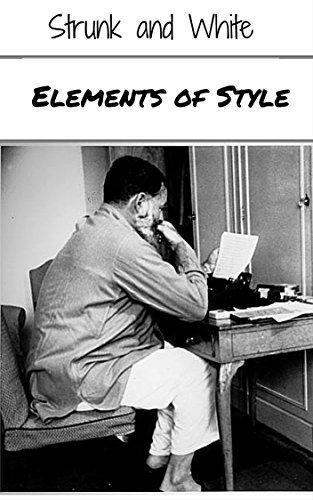Last updated on 2025/08/11
Elements Of Style Summary
William Strunk Jr.
Mastering Clarity and Precision in Writing.
Last updated on 2025/08/11
Elements Of Style Summary
William Strunk Jr.
Mastering Clarity and Precision in Writing.
Description

How many pages in Elements Of Style?
80 pages
What is the release date for Elements Of Style?
"The Elements of Style" by William Strunk Jr. is a timeless guide that distills the art of writing into concise principles, making it an indispensable resource for anyone seeking to enhance their prose. Strunk emphasizes clarity, brevity, and precision in language, urging writers to eliminate unnecessary words and strive for simplicity, thereby allowing their ideas to shine through without obstruction. With its straightforward rules and memorable examples, this concise manual not only empowers writers to express themselves more effectively but also cultivates a deeper appreciation for the power of written communication. Whether you are a student, professional, or seasoned author, engaging with Strunk's insights can transform your writing and elevate your ability to connect with readers.
Author William Strunk Jr.
William Strunk Jr. (1869-1946) was an American professor of English, best known for his influential work in the field of writing and composition. A graduate of Cornell University, where he later taught for over 30 years, Strunk developed a passion for clarity and precision in writing, principles that he sought to instill in his students. His seminal book, "The Elements of Style," co-authored with E.B. White, has become a staple in writing education, revered for its concise guidelines on grammar, style, and usage. Strunk's no-nonsense approach to writing emphasizes the importance of brevity and clarity, earning him a lasting legacy as a guiding force in American literature and the craft of writing.
Elements Of Style Summary |Free PDF Download
Elements Of Style
Chapter 1 | Elementary Rules of Usage
Chapter 1 of "Elements of Style" by William Strunk Jr. presents a collection of foundational rules geared towards enhancing the clarity and correctness of writing. The principles outlined serve as guidelines that promote effective communication and precise expression. 1. Possessives: To indicate possession for singular nouns, simply add 's, irrespective of the ending consonant. Notable exceptions include certain proper names and terms like "Jesus'". Pronouns such as "hers" and "yours" do not require apostrophes, while indefinite pronouns like "one's" do. A common mistake is using "it’s" (meaning "it is") instead of "its" (the possessive form). 2. Comma Usage in Series: In a list of three or more items, employ a comma after every item except the final one. This rule is reflected in constructions such as red, white, and blue, where clarity is enhanced by the "serial comma." In business names, the last comma may often be omitted. 3. Parenthetic Expressions: When an interruption occurs within a sentence, it should be set off by commas. This may include brief phrases or names. Always use a pair of commas if one is needed, and pay attention to parenthetic elements such as dates or titles following names. 4. Independent Clauses: A comma should precede conjunctions when connecting two independent clauses. Special attention is required with conjunctions like “as” or “for”. If a dependent clause precedes an independent one, no comma follows the conjunction. 5. Avoid Comma Splices: Do not connect independent clauses solely with a comma; use a semicolon instead, or a conjunction accompanied by a comma. Maintaining close relationships between clauses improves coherence. 6. Avoid Sentence Fragments: Sentences should not be broken improperly into fragments. Ensure that sentences flow naturally without improperly placed periods, while preserving clarity. 7. Colons: Utilize a colon after an independent clause to introduce lists, appositives, or illustrative quotations. This mark connects closely related ideas, being more formal than a comma. 8. Dashes: Dashes are suitable for marking abrupt breaks or distinct appositives within a sentence. They provide a more casual break than a colon and a stronger separation than a comma. 9. Subject-Verb Agreement: The verb must agree in number with the subject, even when other elements intervene. Singular subjects paired with collective nouns or phrases lead to specialized agreement scenarios, especially with “none” or “every”. 10. Pronoun Case: Maintain the correct form of pronouns based on their grammatical role. Distinguish between nominative and objective cases, ensuring pronouns match their intended function within comparisons. 11. Participial Phrases: Ensure that participial phrases at the start of a sentence refer directly to the subject of the sentence. Misleading references lead to confusion, thus requiring careful restructuring for clarity. These rules encapsulate the essence of effective writing, where attention to detail and adherence to grammatical principles significantly enhance clarity, coherence, and readability. Mastery of these guidelines not only fosters proficiency in composition but also aids writers in engaging their readers through well-structured and stylistically sound prose.
Key Point: Subject-Verb Agreement
Critical Interpretation: Imagine standing in front of a group of people, ready to share your thoughts or present an idea. Just as you want your message to resonate clearly, so too must your words reflect a harmony that is grounded in the rules of language. The principle of subject-verb agreement is not just a grammatical guideline; it’s a reminder of the importance of alignment in all aspects of life. When you ensure that your actions match your intentions—like ensuring that your verb agrees with your subject—you create a stronger, more authentic presence. You inspire trust and comprehension in your audience, whether in writing or conversation. Embracing this clarity helps prevent misunderstandings and showcases the commitment to understanding one another, ultimately fostering deeper connections and more meaningful exchanges.
Chapter 2 | Elementary Principles of Composition
Chapter 2 of "Elements of Style" presents foundational principles for effective writing, emphasizing clarity, structure, and expression. 1. Writers must select a coherent structure prior to writing. Every composition, whether a sonnet or a casual essay, benefits from planning. While spontaneity can be valuable in specific contexts, a clear roadmap enhances the likelihood of achieving the writer's goals. The simplest writing task requires some organizational clarity, as this is integral to effective communication. 2. Paragraphs serve as essential building blocks in writing, allowing writers to compartmentalize topics effectively—each paragraph addressing a single idea or topic. This division aids readers in following the writer’s logic. While brief subjects may be treated in a single paragraph, topics requiring a deeper exploration should be distinctly separated to aid comprehension. Transition sentences can help connect ideas, which is crucial in maintaining flow. 3. Employing the active voice is a significant technique for creating direct and vigorous writing. The active construction typically produces more energetic and engaging prose, while passive constructions tend to weaken statements. Although the passive voice is not to be entirely shunned, habitual use of active voice can significantly enhance the dynamism of the writing. 4. Writers should strive to phrase their statements positively, avoiding tentative language that suggests indecisiveness. Clear, assertive assertions build credibility and engage readers more effectively. Negative constructions should be used strategically and not as a default, as this can dilute the strength of statements. 5. Specificity and concreteness in language enrich writing, bringing clarity and engagement for readers. General statements often leave too much to the imagination, while vivid detail paints clearer pictures and creates connections with the audience. Great writers frequently succeed through their painstaking attention to concrete and relevant details. 6. Conciseness is paramount; every word must contribute to the overall effectiveness of the writing. Superfluous words can cloud meaning and distract readers. Effective writing communicates ideas without unnecessary elaboration, maintaining the reader's focus on key points. 7. Avoiding long sequences of loose sentences or overly complex constructions helps maintain reader interest and engagement. Writers should blend loose and tight sentence structures to create rhythm and variety, enhancing overall readability. 8. Parallel construction enhances clarity and emphasizes relationships among ideas by presenting them in a consistent format. This formulation not only reinforces logical connections but also makes the text more pleasing and accessible to readers. 9. Keeping related words and phrases together in sentences is crucial for clarity. Disorganized word placement can lead to confusion about the relationships and meanings within sentences. A well-structured sentence aids reader comprehension by clarifying the writer's intended message. 10. Consistent tense usage throughout summaries maintains clarity and avoids confusion. Writers should make deliberate choices about tense and adhere to these choices to convey their thoughts clearly and effectively. 11. Placing emphatic words at the end of sentences is a useful technique for highlighting key ideas. The arrangement of sentences, paragraphs, and the overall composition can enhance the impact of the message by strategically emphasizing important points. By systematically applying these principles, writers can achieve greater clarity and impact in their writing, making their communication more effective and engaging for their audience.
Key Point: Clarity through Structure
Critical Interpretation: Imagine sitting down to write your thoughts, heart racing with inspiration and ideas pouring forth. But as you type, the whirlwind of creativity morphs into chaos, and you find your message lost in a sea of disorganization. Chapter 2 of 'Elements of Style' teaches you that before the first word hits the page, planning is paramount. By selecting a coherent structure ahead of time, you transform that chaotic burst of ideas into a well-defined roadmap, guiding your reader seamlessly from start to finish. Each sentence becomes a stepping stone, strategically placed to lead your audience to your intended goal. This principle extends beyond writing—consider how, in life, setting a clear path helps you navigate decisions, projects, or personal goals. With intentionality and organization, you can turn your passions into powerful expressions, engaging both yourself and those around you.
Chapter 3 | A Few Matters of Form
In Chapter 3 of "Elements of Style" by William Strunk Jr., several matters of form are discussed that enhance clarity and readability in writing, emphasizing precision in language use and formatting. 1. When it comes to colloquialisms, it’s important to use them as they are without embellishment, meaning they should not be placed in quotation marks to avoid suggesting they are elitist choices meant for a select few. 2. The use of exclamation marks should be limited to genuine exclamations or commands. For everyday statements, emphasis should be conveyed through the statement itself rather than through punctuation. 3. Formatting manuscripts for publication is crucial; there should be ample space at the top of the first page for editors. The title ought to be situated about a quarter down the page, followed by a blank line. Consistency in margin width enhances professionalism. 4. The correct use of hyphens is essential, especially in compound adjectives; however, avoid hyphenating words that have evolved into single terms. A practical approach combines common sense with dictionary references to ascertain proper usage. 5. Margins should be uniform for a polished look, unless extra space is needed for annotations, in which case a wider left margin is preferred. 6. Numerals must be presented in figures or Roman numerals, particularly in texts—except when featured in dialogue, where it’s appropriate to spell them out. 7. Parentheses require careful punctuation; punctuation on the outside of parentheses is treated as if the contained expression were absent, whereas punctuation inside is based on the expression’s standalone context. 8. Quotations demand careful formatting: formal quotes are preceded by a colon and enclosed in quotation marks, with punctuation rules dictating that commas and periods remain within the quotation marks. When quoting more than a line, the text should be indented and free of quotation marks unless present in the original. 9. Indirect quotations introduced by "that" do not require quotation marks, and phrases from classic literature should also be presented without them. 10. For thorough scholarly work, consistent referencing is necessary, frequently abbreviated in the text but listed explicitly at the end. Punctuation is simplified by omitting less critical terms and being concise in citations. 11. When syllabicating words at the line's end, it’s advised to consult dictionaries for standard syllable separations to maintain structurally sound writing. 12. Titles of literary works typically use italics with initial capitalization; when creating possessive forms, omit the initial articles "A" or "The" for clarity and conciseness. These principles guide writers towards clarity, precision, and professionalism, ensuring that their texts not only convey their intended message but also adhere to established standards of written form, thereby enhancing the reader's engagement and understanding.
Chapter 4 | Words and Expressions Commonly Misused
Chapter 4 of "Elements of Style" by William Strunk Jr. elucidates the common misuse of words and expressions, highlighting the distinction between poor grammar and poor style. The essence of effective writing lies not merely in correct grammar but in clarity and precision. Strunk asserts that in many cases, vague expressions should be replaced by specific language to foster better understanding. 1. The concept of usage is adaptable, with no universal authority on language beyond the patience and curiosity of its users. Those interested in deepening their understanding of language should consult reputable dictionaries and usage guides to explore words and their proper contexts. 2. Misused terms include "aggravate," which means to add trouble, and "irritate," which means to annoy. Correctly employing "all right" in writing as two separate words and distinguishing between "allude" (to indirectly mention) and "elude" is crucial for clarity. 3. Understanding "alternate" (every other in a series) versus "alternative" (one of two possible choices) is vital, as is the distinction between "among" (used with multiple entities) and "between" (used with distinct, individual entities). 4. The conjunction "and/or" should be avoided due to its potential for confusion; instead, it’s preferable to delineate exactly which conditions are being referenced. 5. The word "anticipate" should mean expecting something rather than acting before it happens. Similarly, "anybody" and "any body" must be differentiated, just as "anyone" should be one word. The phrase "as good or better than" can be streamlined to "as good as or better." 6. Stating "as to whether" is unnecessary; simply "whether" suffices. Likewise, "as yet" can usually be simplified to "yet." Using "being" after "regard" is redundant; just state the subject. 7. The conjunction "but" can be misused and lead to awkward construction, especially when used excessively within a sentence. Additionally, "can" should denote ability rather than permission, while the phrase "I could care less" is a misunderstanding of the dismissive "I couldn’t care less." 8. The grammatical distinction between "fewer" (for countable items) and "less" (for uncountable quantities) is often misapplied, and similarly, phrases like "kind of" should be restricted to their literal meanings. 9. Verb forms such as "lay" and "lie" need careful differentiation, while adopting contemporary phrases like "contact" can lead to vagueness. Grammar demands clarity — for instance, use "data" as a plural noun. 10. It’s essential to avoid overused terms like "due to," "interesting," and "meaningful," as they dilute meaning and lead to vague expressions. Instead, opt for specific language that conveys precise ideas. 11. Using "unique" improperly implies degrees of uniqueness, whereas it should denote absolute singularity. The misuse of "utilize" often can be replaced with the simpler "use." 12. The distinctions between "that" (restrictive) and "which" (non-restrictive) should guide sentence construction, emphasizing clarity in their application. 13. Vague terms such as "the fact is" and clichés like "the foreseeable future" should be avoided to enhance directness and vigor in writing. 14. Pronouns should remain consistent in number and gender with their antecedents; thus, one should say "each of us knows he is fallible" instead of the confusing "they." 15. Finally, redundant phrases and unnecessary qualifiers, including "personally" and phrases like "worth while," should be minimized. The goal is to reflect clarity, precision, and concise language in writing. In summary, the key to eloquent writing lies in the precise choice of words and the avoidance of common pitfalls that dilute meaning. Mastery of language reflects a writer's intent and enhances their communication efficacy.
Key Point: The Importance of Clarity and Precision in Language
Critical Interpretation: Imagine a world where every conversation and written piece you engage in is infused with clarity and precision. By adopting Strunk's key principle of replacing vague expressions with specific language, you empower yourself to communicate more effectively. Every interaction, whether in a personal note to a friend or a professional email, invites deeper understanding and connection. Embrace this approach as a personal philosophy; let it inspire you to choose your words thoughtfully. By doing so, you not only enrich your own expression but also ensure that your thoughts resonate clearly with others, fostering a more meaningful exchange of ideas.
Chapter 5 | An Approach to Style (With a List of Reminders)
Chapter 5 of "Elements of Style" by William Strunk Jr. discusses the nuanced and often elusive concept of writing style, which transcends merely adhering to grammatical rules. This chapter serves as a reflective and practical guide for writers, emphasizing that style is an integral part of writing, not a mere embellishment. Strunk suggests that the essence of a writer’s voice is revealed through their choice of words and how they communicate their ideas, and presents several principles aimed at helping writers cultivate a distinctive and effective style. 1. Emphasize clarity and authenticity by placing the writer's personality in the background to allow the writing's substance to resonate with readers. A true style emerges organically as proficiency in language develops, and writing becomes a vehicle for self-expression. 2. Embrace naturalness in writing. Writers should aim to use language that feels comfortable and instinctive to them, recognizing that even natural expression may require refinement and editing. 3. Consider a suitable structure before composing. Writers are encouraged to plan their content thoughtfully as a way to avoid meandering. Design gives shape to writing, whether it's a simple list or a complex narrative. 4. Use strong nouns and verbs to create vigorous and captivating prose. The strength of writing often hinges on selecting impactful words rather than relying on adjectives and adverbs, which may dilute the writing’s potency. 5. Accept that revision is an essential part of the writing process. Effective writing usually requires reworking, and writers should remain open to substantial edits in order to enhance clarity and coherence. 6. Strive for conciseness. It is vital to avoid overwriting, as complex or overly elaborate prose can be off-putting to readers. Writers should routinely prune unnecessary words for clearer expression. 7. Avoid exaggeration to maintain credibility. Overstatements can make readers skeptical of the writer’s judgment, which can undermine the entire piece. 8. Refrain from using qualifiers excessively. Words like "very" or "really" detract from the strength of the writing; a more straightforward approach is usually preferable. 9. Cultivate a sincere tone and avoid forced levity. A breezy manner can come across as insincere or superficial. Authenticity and straightforwardness are more engaging. 10. Use conventional spelling and grammar. Writers should adhere to standard spelling to avoid distractions that could confuse readers and detract from their message. 11. Be selective with explanations. Instead of overtly describing the emotional context of dialogue with adverbs, let the characters’ words convey their feelings. 12. Construct clear dialogue. It is essential to clarify who is speaking for coherence and fluidity, ensuring readers can follow conversations seamlessly. 13. Make word choices carefully. Avoid fancy or elaborate alternatives when simple words will suffice, as this can lead to muddied meanings. 14. Maintain clarity as a priority in writing. Strunk underscores that, although not every passage needs to be explicitly clear, clarity enhances communication and understanding. 15. Steer clear of opining indiscriminately. Dispersing personal opinions without a relevant context can come off as self-indulgent and detract from the writing’s purpose. 16. Exercise caution with figurative language. While comparisons can be effective, an overabundance may overwhelm readers and cloud the intended message. 17. Avoid shortcuts that compromise clarity. Writers should spell out names and concepts to ensure accessibility for all readers, especially when initials could cause confusion. 18. Be judicious with foreign terms. Using foreign languages can alienate readers unless employed thoughtfully and consistently. 19. Prefer standard language over trendy or eccentric expressions. While linguistic evolution is natural, sticking to established usage generally aids in maintaining clarity and understanding. 20. Recognize that style mostly stems from the writer's mindset and integrity. Writing should come from a place of faith in the value of the message and trust in the reader’s understanding. In summation, Chapter 5 not only provides pragmatic writing tips but also encourages introspection among writers about their voice and style. Strunk suggests that true style emerges through a disciplined approach to writing, characterized by clarity, sincerity, and strong, purposeful language. As aspiring writers navigate their journey, such principles serve as guiding stars illuminating a unique and clear path toward effective communication.







